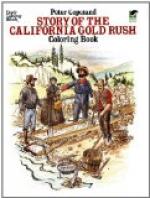For years this debris was washed into the rivers or on farming lands, filling up and ruining both, and leading to endless quarrels between farmers and miners. But at last the courts stopped hydraulic mining except in northern counties, where debris went into the Klamath River, upon which no boats could run and near which was little farming. But all the mines in the Sacramento and San Joaquin river-basins were idle till, in 1893, Congress appointed a Debris Commission. These mining engineers issue licenses to work the mines when satisfied that the debris will be kept out of the rivers. There are in the state many hundred thousand acres of gold-bearing gravel lands yet untouched, that could be worked by hydraulic mining.
In drift-mining the rich gravel is covered by hard lava rock thrown up by some old volcanic outburst. Tunnels are driven by blasting with dynamite, or by drilling under the rock to reach the gravel which usually lies in the buried channel of an old river. The long drifts, or tunnels, needed are very expensive and only mine owners with capital can work these claims.
Richest of all are the quartz mines, where beautiful white rock, rich with sparkling gold, is found in veins, or “lodes,” cropping out of hillsides or dipping down under the earth. The great “Mother-lode” of our state runs like an underground wall across Amador, Calaveras, Tuolumne, and Mariposa counties and has been traced for eighty miles.
Some poor miner usually finds a ledge of quartz-rock and digs down the way the ledge goes. He puts up a windlass, worked by hand, over the well-like hole he has dug out, and hoists the ore out in buckets. But he soon finds, as the hole or shaft goes deeper, that he must timber the sides to keep them from caving in, that he must have an engine to raise the ore and a mill to crush the hard rock. So he sells out to a company of men, who put in costly machinery, deepen the shaft, and by heavy expenditure get large returns.
The quartz ledges dip and turn, so tunnels and cross-cuts are run to follow the golden vein, and all these are timbered with heavy wooden supports to keep the earth and rock from falling in on the men. The miners work in day and night gangs, using dynamite to break up the hard rock, and sending ore up in great iron buckets, or in cars if the tunnel ends in daylight, on the hillside. Sometimes the miners strike water, and that must be pumped out to keep the mine from being flooded.
The ore is crushed by heavy stamps, or hammers, and then mixed with water and quicksilver. This curious metal, quicksilver, or mercury, is fond of gold and hunts out every little bit, the two metals mixing together and making what is called an amalgam. This is heated in an iron vessel, and the quicksilver goes off in steam or vapor, leaving the gold free. The quicksilver, being valuable, is saved and used again, while the gold, now called bullion, is sent to the mint to be coined into bright twenties, or tens, or five-dollar pieces.




